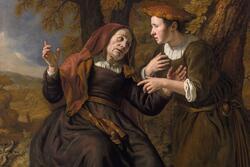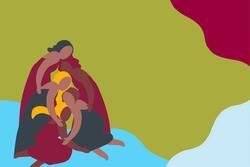My Connection to Ruth
When I was little, my parents brought home a drawing of Ruth. At first, I was indifferent to the piece because I didn’t really understand it. I slowly grew interested in the drawing when I learned about feminist literary criticism in my English class last year and wrote essays applying this literary theory. I realized that Ruth's bravery and commitment to her mother-in-law can inspire my efforts to uplift the women of my traditional Jewish community.
When I first learned the story of Ruth, I thought it was not very exciting. Ruth’s story is told in the Bible in the book that is named after her, Megillat Ruth. She is originally from Moab. She and another Moabite woman, Orpah, married Jewish brothers. Eventually, both the father of these brothers and the brothers themselves passed away. That left Ruth and Orpah’s mother-in-law Naomi a childless widow.
Naomi tells her daughters-in-laws that she will be returning to Israel. Neither of them want to be separated from her but she begs them to remarry. While Orpah stays behind, Ruth refuses to leave Naomi’s side and they make their way back to Bethlehem together. While Ruth is harvesting wheat in the field of a distant family member, Boaz, Ruth catches his eye. Ruth returns back to Naomi and she instructs Ruth to court him and Ruth does just that. Boaz and Ruth get married.
Thanks to this beautiful drawing of Ruth in my house, I was able to develop an appreciation for Ruth and how her journey connects to mine. The drawing features Ruth clad in red with wheat dangling off of her shoulder as a wheat field encompasses her and the Beit Hamikdash in the backdrop. The most interesting stylistic choice is that Ruth is the sole subject and the only entity drawn in full color while everything else is created with neutrals. Ruth is notorious for her modesty, yet here she is depicted in red which some ultra-Orthodox communities consider to be a “sinful” color. This glaring contradiction is fascinating as it isn’t the type of painting that relays her beauty or that attaches her to who her father, husband, or children were. Rather, the drawing sheds light on her sheer strength and dedication to her faith.
I often attempt to tap into Ruth’s power as I rise above the social confines of my community. Usually, women in my Orthodox Persian community are in the background and are never praised or celebrated or given leadership roles the same way their male counterparts are. For example, at my synagogue, women do not present speeches regarding the week's Torah portion as the role is always given to a man. Women are often praised for their beauty and outfits while men are applauded for their education and careers. Fighting against this, I attempt to eradicate these obligations by being outspoken regarding the role women play in my community. I adore catching others off guard with my knowledge regarding the Torah portion and current events. Ruth did not conform to societal expectations as she untraditionally courted Boaz at a time when most women had to be proposed to by a man.
Ruth's dedication to her religion, depicted in this painting with the Beit Hamikdash behind her, is something that I strive for. Ruth sacrificed her position of respect, wealth, and status to move to Israel and to pursue her Judaism alongside Naomi. She firmly believed in her faith to guide her in this foreign land. Her belief in God is admirable and I truly strive to discover and tap into the type of trust she had in God and her own convictions. Women from her time period were almost always discussed in the context of their beauty and referred to as who their fathers, husbands, and sons were but my portrait of her sheds light on her strength and dedication to her faith.
This piece hangs near my dining room table and I often glance at it. For me, it is very intriguing as the other Jewish art and Judaica that decorates my home are usually the ritual objects used to fulfill mitzvot like Menorahs, Shofars, and Torahs. But Ruth is the only character from all of Tanakh that we have a drawing of.
I deeply appreciate the way Ruth is depicted as she is the sole subject in the drawing which represents how she was not defined by any man that she was attached to but rather she is remembered for her loyalty to her people, her immense strength, and ability to be the main subject of her painting, and her own Megillah.
This piece was written as part of JWA’s Rising Voices Fellowship.







